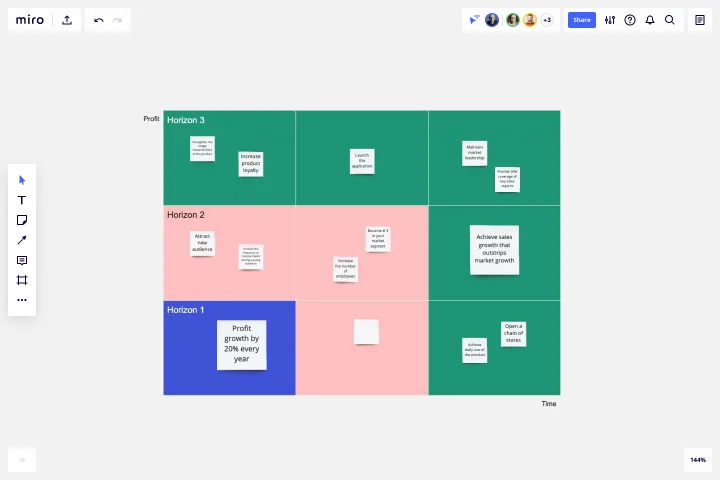3 Horizons of Growth Template
Concurrently manage current and future opportunities for growth.
Trusted by 65M+ users and leading companies
About the 3 Horizons of Growth template
What is the 3 Horizons of Growth model?
As companies grow, it can be difficult to keep innovating at the same pace. Innovation is often discarded in favor of inertia. To keep up their momentum, organizations have to balance their existing business with potential growth opportunities. That’s where the 3 Horizons framework comes in.
First introduced in The Alchemy of Growth, the 3 Horizons of Growth model helps companies assess potential growth opportunities while finding ways to maintain existing business. C-suite leaders use the 3 Horizons model as a blueprint for investing in current products and services while looking to the future. But its use is not confined to the C-suite. Teams across the organization can make use of the 3 Horizons model to ensure their projects map to the organization’s goals.
What are the 3 Horizons?
The 3 Horizons represent current opportunities, future opportunities that require substantial investment, and ideas for future opportunities that can be used as experiments, pilots, or minority stakes in new businesses.
How do you use the 3 Horizons of Growth template?
Use the 3 Horizons of Growth template when you want to strategically think about your business currently and in the future. The x-axis represents time, but keep in mind that it’s not an indication of what you should be thinking about now vs. later. You should be thinking about all three horizons at the same time. You will always want to cycle between where your business is strong now, which opportunities you believe will be successful in the future, and which opportunities you’d like to explore further.
What are the benefits of the Horizons of Growth model?
Benefit 1 - Take stock of current opportunities. To start, the Horizons of Growth model requires you to make a note of all current opportunities. This exercise helps frame the rest of the model and ensure you’re aligned with your team.
Benefit 2 - Identify future opportunities for investment. The Horizons model empowers you to pinpoint opportunities to maximize cash flow. Use the model to brainstorm with your team and come up with ideas for quick wins.
Benefit 3 - Experiment and iterate. Many C-suite execs use the Horizons of Growth model to find potential areas for experimentation. Those might include research projects, pilot programs, or minority stakes in new business.
When to use the 3 Horizons of Growth model
1. To foster a culture of innovation
2. To create a framework necessary for achieving long-term initiatives
3. To identify opportunities for new business
4. To enhance business analysis and focus on potential challenges
5. To prepare a developmental plan
Get started with this template right now.
Growth Experiments Template
Works best for:
Leadership, Desk Research, Strategic Planning
Many ambitious companies are eying the future and aiming to grow. But growth decisions can be leaps of faith that are risky and costly. That’s why growth experiments make so much sense. They offer a systematic six-step method that reveals which strategies are most effective, how they’ll affect your revenue, and how they compare to your past approaches. By helping you test out your strategies for scaling your business before you fully commit, growth experiments can save you serious time, resources, and money.
Creative Brief Template
Works best for:
Design, Marketing, Desk Research
Even creative thinkers (or maybe especially creative thinkers) need clear guidelines to push their ideas in productive, usable directions. And a good creative lays down those guidelines, with information that includes target audience, goals, timeline, and budget, as well as the scope and specifications of the project itself. The foundation of any marketing or advertising campaign, a creative brief is the first step in building websites, videos, ads, banners, and much more. The brief is generally prepared before kicking off a project, and this template will make it easy.
Assumption Grid Template
Works best for:
Leadership, Decision Making, Strategic Planning
Someone wise once said that nothing in life is certain. But the waters of the business world? It can seem especially uncertain and unclear. An Assumption Grid can help you navigate those waters and make your decisions confidently. It organizes your business ideas according to the certainty and risk of each — then your team can discuss them and make judgment calls, prioritize, mitigate risk, and overcome uncertainties. That’s why an Assumption Grid is a powerful tool for getting past the decision paralysis that every team occasionally faces.
Timeline Design
Works best for:
Timeline, Planning
The Timeline Design template is perfect for creating visually engaging timelines. It helps you showcase project milestones, deadlines, and important events in a clear and attractive format. Ideal for presentations and reports, this template ensures your timeline is both informative and visually appealing.
SIPOC Template
Works best for:
Agile Methodology, Strategic Planning, Mapping
A SIPOC diagram maps a process at a high level by identifying the potential gaps between suppliers and input specifications and between customers and output specifications. SIPOC identifies feedback and feed-forward loops between customers, suppliers, and the processes and jump-starts the team to think in terms of cause and effect.
OKR Planning Template
Works best for:
Strategic Planning, Meetings, Workshops
The OKR Planning template helps you turn exhaustive OKR sessions into dynamic and productive meetings. Use this template to make OKR planning more interactive, guiding your team through the session with creative Ice Breakers and Brainstorms, so you can co-create your OKRs and define the key results and action plans to achieve them.
